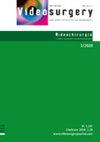Preoperative computed tomography-guided localization for pulmonary nodules: comparison between hook-wire and anchored needle localization
IF 1.9
4区 医学
Q2 SURGERY
引用次数: 0
Abstract
IntroductionBoth hook-wire (HW) and anchored needle (AN) techniques can be used for preoperative computed tomography (CT)-guided localization for pulmonary nodules (PNs). But the outcomes associated with these two materials remain unclear.
Aim
To assess the relative safety and efficacy of preoperative CT-guided HW and AN localization for PNs.
Material and methods
This was a retrospective analysis of data collected from two institutions. Consecutive patients with PNs between January 2020 and December 2021 who underwent preoperative CT-guided HW or AN localization followed by video-assisted thoracoscopic surgery (VATS) procedures were included in these analyses, which compared the safety and clinical efficiency of these two localization strategies.
Results
In total, 98 patients (105 PNs) and 93 patients (107 PNs) underwent CT-guided HW and AN localization procedures, respectively. The HW and AN groups exhibited similar rates of successful PN localization (95.2% vs. 99.1%, p = 0.117), but the dislodgement rate in the HW group was significantly higher than that for the AN group (4.8% vs. 0.0%, p = 0.029). The mean pain score of patients in the HW group was significantly higher than that for the AN group (p = 0.001). HW and AN localization strategies were associated with comparable pneumothorax (21.4% vs. 16.1%, p = 0.349) and pulmonary hemorrhage (29.6% vs. 23.7%, p = 0.354) rates. All patients other than 1 individual in the HW group successfully underwent VATS-guided limited resection.
Conclusions
These data suggest that AN represents a safe, well-tolerated, feasible preoperative localization strategy for PNs that may offer value as a replacement for HW localization.
术前计算机断层扫描引导下的肺结节定位:钩丝定位与锚定针定位的比较
导言钩线(HW)和锚针(AN)技术均可用于术前计算机断层扫描(CT)引导下的肺结节(PNs)定位。材料和方法这是对两家机构收集的数据进行的回顾性分析。2020年1月至2021年12月期间,连续接受术前CT引导下HW或AN定位,然后进行视频辅助胸腔镜手术(VATS)的PNs患者被纳入这些分析中,这些分析比较了这两种定位策略的安全性和临床效率。HW组和AN组的PN定位成功率相似(95.2% vs. 99.1%,P = 0.117),但HW组的移位率明显高于AN组(4.8% vs. 0.0%,P = 0.029)。HW 组患者的平均疼痛评分明显高于 AN 组(p = 0.001)。HW和AN定位策略的气胸率(21.4% vs. 16.1%,p = 0.349)和肺出血率(29.6% vs. 23.7%,p = 0.354)相当。结论:这些数据表明,AN是一种安全、耐受性良好、可行的PN术前定位策略,可能具有替代HW定位的价值。
本文章由计算机程序翻译,如有差异,请以英文原文为准。
求助全文
约1分钟内获得全文
求助全文
来源期刊
CiteScore
2.80
自引率
23.50%
发文量
48
审稿时长
12 weeks
期刊介绍:
Videosurgery and other miniinvasive techniques serves as a forum for exchange of multidisciplinary experiences in fields such as: surgery, gynaecology, urology, gastroenterology, neurosurgery, ENT surgery, cardiac surgery, anaesthesiology and radiology, as well as other branches of medicine dealing with miniinvasive techniques.

 求助内容:
求助内容: 应助结果提醒方式:
应助结果提醒方式:


